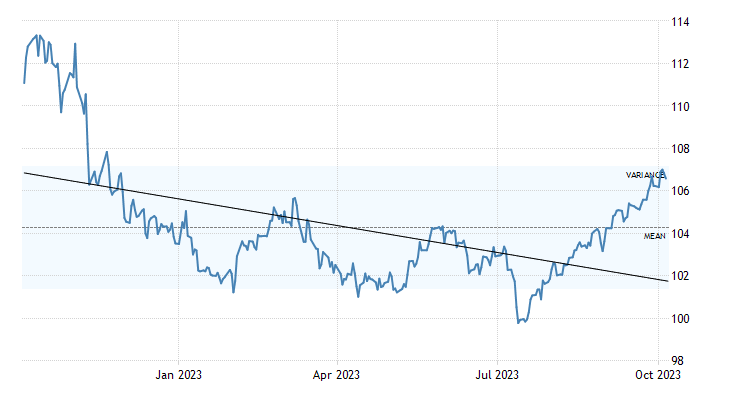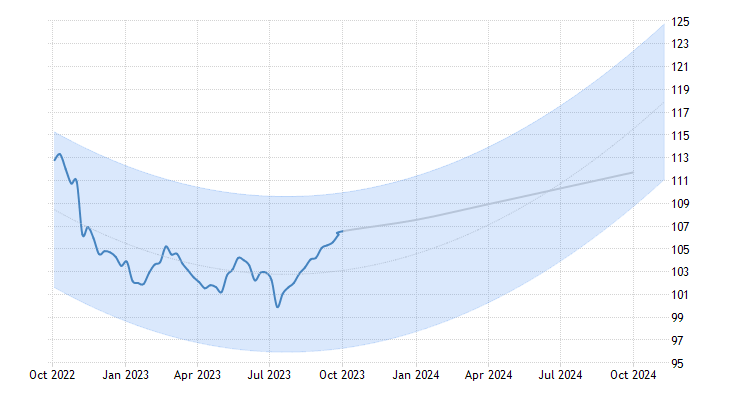The Dollar Index Signal Unveiled
In the dynamic world of global finance, few indicators capture the attention of traders and investors quite like the Dollar Index Signal. As of Wednesday, the dollar index remained relatively stable at 107, a level reminiscent of its highs last observed in November the previous year. This stability follows a period of economic data that has left market participants in a state of anticipation, navigating through a maze of mixed signals. In this extensive analysis, we delve into the intricacies of the dollar’s recent performance, dissecting key economic metrics and the broader market sentiment. Our objective is to provide clarity in understanding the forces that shape the dollar’s trajectory.
The Tale of Mixed Economic Data
The Dollar Index Signal, reflecting the strength of the US dollar against a basket of major currencies, has recently been influenced by a tapestry of economic reports. First and foremost, the ISM Services PMI signaled a slowing pace of growth in the services sector, though it still remained robust. Simultaneously, factory orders exceeded expectations, painting a picture of surprising resilience. Conversely, the ADP report cast a shadow by revealing that the US private sector added the fewest jobs since January 2021, suggesting a potential cooling of the labor market. This report was in stark contrast to the JOLTS report, which, earlier in the week, showed an unexpected surge in job openings in August. Meanwhile, the ISM Manufacturing PMI for September hinted at the smallest contraction in factory activity in nearly a year.

Navigating Uncertainty
The Dollar Index Signal is also significantly influenced by the utterances of Federal Reserve officials. Their recent hawkish comments have heightened expectations that borrowing costs will remain elevated for an extended period. This prospect, in turn, has implications for the greenback’s performance. With interest rates playing a pivotal role in currency valuation, the specter of higher borrowing costs can potentially strengthen the dollar. However, this shift could also hinder economic growth, as it may deter borrowing and spending.
Dollar Index and International Relations
Beyond economic data and monetary policy, the Dollar Index Signal is sensitive to geopolitical developments and international relations. The dollar’s position as the world’s primary reserve currency means that its value is intricately tied to global events. Geopolitical tensions, trade disputes, and diplomatic relations all contribute to the dollar’s performance. For instance, trade tensions between the United States and China have historically put downward pressure on the dollar, as uncertainty in the global trade landscape can erode investor confidence in the currency.

A Global Perspective
Expanding our perspective globally, it’s crucial to acknowledge that the dollar index is not merely a reflection of the US economy. Other major economies also play a significant role in shaping its trajectory. The euro, pound, and Aussie have all influenced the dollar’s recent performance. While the greenback exhibited slight weakness against these currencies, the yen remained below the 150 threshold. This complex interplay of currencies underscores the interconnectedness of the global financial system and its impact on the Dollar Index Signal.
Investor Strategies in a Volatile Market
Given the mixed signals and the ever-evolving landscape, investors must tread carefully in the current environment. A well-thought-out strategy is essential to navigate the uncertainties surrounding the Dollar Index Signal. Diversification across asset classes and currencies can provide a hedge against currency risk. Additionally, staying informed about global economic developments, central bank policies, and geopolitical events is crucial for making informed decisions.

Conclusion
In conclusion, the Dollar Index Signal is a multifaceted indicator influenced by a myriad of factors, including economic data, monetary policy, international relations, and global market dynamics. Its recent stability at 107, near November 2022 highs, is a testament to the intricate web of forces at play. As investors and traders navigate this complex landscape, it is imperative to remain vigilant and adaptable, adjusting strategies in response to evolving market conditions. By staying informed and maintaining a diversified portfolio, market participants can better position themselves to harness the opportunities and mitigate the risks associated with the Dollar Index Signal.






mexican pharmaceuticals online
http://cmqpharma.com/# medication from mexico pharmacy
medicine in mexico pharmacies
mexico drug stores pharmacies: mexican pharmacy – reputable mexican pharmacies online
medicine in mexico pharmacies: online mexican pharmacy – mexican mail order pharmacies
best rated canadian pharmacy: canadian drug stores – reliable canadian pharmacy
https://foruspharma.com/# medication from mexico pharmacy
canada rx pharmacy: canada rx pharmacy world – pharmacy in canada
buying prescription drugs in mexico online: reputable mexican pharmacies online – mexican pharmacy
http://canadapharmast.com/# canadian world pharmacy
canadianpharmacyworld canadian discount pharmacy ed meds online canada
mexican pharmaceuticals online pharmacies in mexico that ship to usa buying prescription drugs in mexico
my canadian pharmacy review: canadian drug stores – legitimate canadian pharmacies
mail order pharmacy india: Online medicine order – best india pharmacy
http://foruspharma.com/# buying prescription drugs in mexico online
best india pharmacy: india online pharmacy – world pharmacy india
mexican border pharmacies shipping to usa buying prescription drugs in mexico online reputable mexican pharmacies online
pharmacies in mexico that ship to usa: mexican pharmacy – п»їbest mexican online pharmacies
mexican pharmaceuticals online: mexican drugstore online – mexico drug stores pharmacies
mexican mail order pharmacies: buying from online mexican pharmacy – buying from online mexican pharmacy
https://canadapharmast.online/# best canadian pharmacy online
top 10 online pharmacy in india indian pharmacies safe india pharmacy
canadian pharmacy phone number: canadian drugs pharmacy – legitimate canadian pharmacies
Online medicine home delivery: top 10 online pharmacy in india – buy medicines online in india
https://foruspharma.com/# mexican drugstore online
canadianpharmacy com ed drugs online from canada is canadian pharmacy legit
canada pharmacy reviews: canadian pharmacy king reviews – canadian drug stores
canadian pharmacy ltd: canadian pharmacy – canada pharmacy reviews
mexican drugstore online: mexico pharmacies prescription drugs – mexican mail order pharmacies
https://doxycyclinedelivery.pro/# doxycycline 1000mg best buy
doxycycline generic cost: doxycycline price uk – doxycycline hyclate 100mg price
https://ciprodelivery.pro/# ciprofloxacin
doxycycline buy no prescription doxycycline tetracycline can you buy doxycycline over the counter in south africa
canadian pharmacy doxycycline: doxycycline 1mg – doxycycline 100mg tablets for sale
https://clomiddelivery.pro/# cost of generic clomid
http://clomiddelivery.pro/# how to get cheap clomid pills
http://amoxildelivery.pro/# amoxicillin for sale online
buy doxycycline online 270 tabs doxycycline 100mg cost doxycycline for sale online
https://doxycyclinedelivery.pro/# doxycycline 100mg generic
doxycycline india pharmacy: doxycycline 150 mg capsules – where to buy doxycycline online
https://paxloviddelivery.pro/# Paxlovid over the counter
http://paxloviddelivery.pro/# Paxlovid over the counter
http://clomiddelivery.pro/# can you buy cheap clomid no prescription
ciprofloxacin ciprofloxacin mail online ciprofloxacin generic
amoxicillin 500 mg capsule: amoxicillin without a prescription – amoxicillin 500mg over the counter
https://doxycyclinedelivery.pro/# doxycycline medication
http://amoxildelivery.pro/# amoxicillin 500mg price canada
https://clomiddelivery.pro/# can i order generic clomid without dr prescription
buy cipro online canada buy cipro cheap cipro ciprofloxacin
paxlovid buy: Paxlovid over the counter – buy paxlovid online
http://paxloviddelivery.pro/# paxlovid generic
http://paxloviddelivery.pro/# paxlovid pill